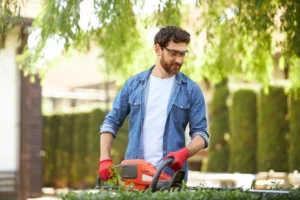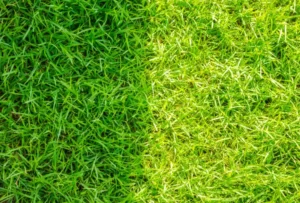Want a front yard that looks incredible without spending hours on upkeep? A low maintenance front yard landscaping design is the perfect solution for busy homeowners, eco-conscious families, or anyone looking to simplify outdoor chores. With the right plants, materials, and layout, you can enjoy a lush and stylish front yard that requires minimal effort.
In this guide, we’ll share easy, effective, and affordable low maintenance front yard ideas that blend beauty with functionality. Let’s get started!
1. Plant Sun Lovers in the Right Spot

One of the easiest ways to embrace a low maintenance landscaping design is to plant smart. Choose sun-loving flowers like lavender, black-eyed Susans, and yarrow—and make sure they get plenty of light. When plants grow where they’re happiest, they thrive with little water or care, making your low maintenance front yard even easier to manage.
2. Use Evergreens for Structure and Simplicity

Evergreens are a foundational piece of any low maintenance front yard landscaping design. They stay green year-round, require very little pruning, and add structure to your Bay arealandscape design. Try boxwoods, junipers, or dwarf spruces for a polished, clean look without constant trimming or seasonal replanting.
3. Incorporate Ornamental Grasses for Movement and Texture

Looking to add visual interest without increasing maintenance? Ornamental grasses like fountain grass, blue fescue, and feather reed grass bring motion, depth, and elegance to your yard. These drought-tolerant beauties thrive in a variety of climates and are a must-have in any low maintenance front yard.
4. Highlight Your Entry with Raised Beds or Container Gardens
Raised garden beds and container arrangements near your front door create a warm, welcoming look with minimal effort. They’re perfect for showcasing seasonal color, controlling weeds, and simplifying maintenance. This is one of the easiest and most effective low maintenance front yard ideas that adds instant charm and curb appeal.
5. Use Durable, Permeable Hardscaping
Replacing grass with stone pathways, gravel borders, or decomposed granite reduces the need for mowing and watering. Permeable hardscapes are also great for drainage and are a key feature in smart low maintenance landscaping designs. These elements create a clean, modern look while keeping your yard low-effort.
6. Replace Grass with Ground Cover or Artificial Turf
Grass requires constant mowing, watering, and feeding. Instead, consider drought-tolerant ground covers like creeping thyme, clover, or sedum. Or, opt for artificial turf—a popular choice in low maintenance front yard landscaping design—for a lush green lawn look without the maintenance.
7. Install Automated Irrigation Systems
A smart irrigation system or drip watering setup can drastically cut down on your time spent in the yard. It ensures plants get just the right amount of water, reducing waste and supporting the goals of low maintenance landscaping. Set it and forget it—that’s the beauty of automation!
Why a Low Maintenance Front Yard Landscaping Design Is the Smart Choice
Opting for a low maintenance front yard landscaping design isn’t just about cutting down on yard work—it’s about creating a smarter, more sustainable outdoor space that works for you. Today’s homeowners are busier than ever, and the last thing you want is to spend weekends watering, mowing, or constantly replanting. With the right low maintenance front yard ideas, you can enjoy a beautiful, polished yard without the daily upkeep.
Here’s why making the switch is a game-changer:
✅ Reduced Water Usage & Eco-Conscious Gardening
One of the biggest advantages of a low maintenance front yard is water efficiency. By choosing drought-tolerant plants, native species, and ground covers, you naturally reduce your dependence on irrigation. Add in smart watering systems like drip irrigation or timed sprinklers, and you’ll significantly cut down your water bill—all while supporting sustainable gardening practices.
This kind of low maintenance landscaping design is especially ideal for California’s dry seasons and water restrictions. You can keep your yard looking green and vibrant without wasting precious resources.
✅ Lower Landscaping Costs Over Time
Traditional front yards often require regular mowing, fertilizing, replanting, and seasonal maintenance. These recurring expenses add up quickly—especially if you’re hiring help. With a low maintenance front yard landscaping design, you make a smart upfront investment that pays off long-term.
Think durable hardscaping, artificial turf, native perennials, and shrubs that thrive on their own. These features drastically reduce the need for ongoing maintenance services, plant replacements, and water bills—saving you money year after year.
✅ Minimal Upkeep for Busy Lifestyles
Whether you’re juggling a full-time job, family, or travel, a low maintenance front yard fits seamlessly into your life. Forget the stress of constant lawn care or wondering if your plants need attention. Many low maintenance landscaping designs are set-it-and-forget-it systems—with automated watering, slow-growing plants, and mulch to keep weeds away.
With less time spent maintaining your yard, you’ll have more time to actually enjoy it.
✅ Year-Round Curb Appeal Without the Effort
A thoughtfully designed low maintenance front yard landscaping design offers consistent curb appeal through all four seasons. Evergreens, ornamental grasses, and flowering shrubs ensure your yard stays attractive whether it’s spring bloom time or the middle of winter. Raised beds and container gardens add depth and color without constant attention.
And when your home looks great from the outside, it not only boosts pride of ownership—it also increases property value.
✅ Durable and Drought-Resistant Designs That Last
Choosing the right materials and plants makes all the difference. Using gravel paths, stone borders, and tough, climate-appropriate greenery ensures your front yard holds up against wear and tear—from harsh sun to heavy rain.
In areas like the Bay Area or San Jose, low maintenance landscaping designs that include drought-resistant options like succulents, sedum, and native grasses thrive with minimal effort. These hardy elements keep your landscape looking intentional and cared-for, even in unpredictable weather.
Final Words
Designing a low maintenance front yard doesn’t have to be complicated. At Lakota Design Group, we specialize in low maintenance front yard landscaping design that blends creativity, sustainability, and style. Whether you’re looking to install artificial turf, add durable hardscaping, or choose the perfect plant palette, our team can make it happen.
Serving San Jose and the Bay Area, we’re known for personalized service, exceptional craftsmanship, and award-winning outdoor designs. Let’s build your low-maintenance dream yard—stress-free and stunning.
FAQs
What Is Low Maintenance Front Yard Landscaping?
Low maintenance front yard landscaping refers to creating an outdoor space that requires minimal care, water, and upkeep. This can include using drought-tolerant plants, incorporating hardscaping features like pathways and patios, and selecting materials that don’t require constant attention or replacement.
How Can I Create A Low Maintenance Front Yard?
To create a low-maintenance front yard, focus on using native plants, perennials, and drought-resistant species. Incorporate hardscaping elements such as gravel, stone pathways, or artificial turf. Use mulch or ground covers to reduce weeding and install smart irrigation systems for efficient watering.
What Plants Are Best For Low Maintenance Front Yard Landscaping?
For low maintenance front yards, choose native plants, succulents, and drought-tolerant species such as lavender, agave, ornamental grasses, or coneflowers. These plants require minimal water, fertilizer, and maintenance, making them perfect for easy-care landscapes.
Can I Have A Lush Lawn With Low Maintenance Landscaping?
Yes, you can achieve a lush lawn with low maintenance by opting for artificial turf or using drought-resistant grass varieties that require less water and mowing. Artificial turf provides the appearance of a manicured lawn year-round with minimal upkeep.
How Does Mulch Help In Low Maintenance Landscaping?
Mulch helps in low-maintenance landscaping by suppressing weed growth, retaining moisture, and improving soil health. It also gives a neat, finished look to garden beds and reduces the need for frequent weeding or soil replenishing.
What Is Xeriscaping, And How Can It Be Used For Low Maintenance Landscaping?Xeriscaping is a landscaping technique that focuses on water conservation by using drought-tolerant plants and efficient irrigation methods. It reduces water usage and maintenance by selecting plants that thrive in dry conditions, such as succulents, cacti, and native grasses.





